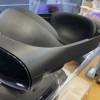Surface Duo review—Orphaned Windows hardware makes a poor Android device

After one of the strangest run-ups to launch in smartphone history, the Microsoft Surface Duo is here. Microsoft's first-ever Android phone (sorry, we're not counting the Nokia X) was announced and demoed an entire year before its release, hinting at what a long and winding road the Surface Duo took from inception to shipping. The hardware apparently dates back to plans to revitalize Windows for phones, but after that plan fell through, the hardware was upcycled into the most head-scratching Android phone of the year.
The Surface Duo sales pitch is that foldable display technology isn't ready yet, so try this best-we-can-do-right-now version that features two rigid, 5.6-inch OLED displays attached together with a 360 hinge. Microsoft is calling this a "productivity" device thanks to it having the side-by-side app capability of a tablet-style foldable smartphone without any of the janky display technology. Microsoft's website also says the Duo was designed to "inspire people to rethink how they want to use the device in their pocket," indicating that the company definitely sees this as a primary device.
I bring up Microsoft's sales pitch because, boy, is the Surface Duo bad at doing the things Microsoft says it's supposed to be good at. The phone feels like it was made without any respect to ergonomics, hand size, pocket-size, or anything that makes a good Android phone. It has crippling productivity problems that negate any benefit you could get from the two-screen design, it's extremely awkward in day-to-day use, and it's very buggy. The phone is missing a whole host of features you would expect for the stratospheric $1400 asking price, and even the hardware that is here seems like it's a least a year old.









































































